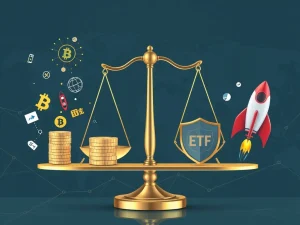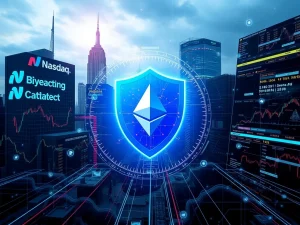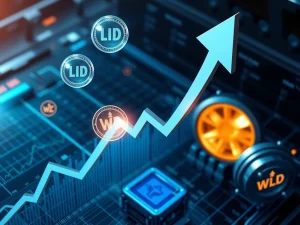BlockDAG: The Astonishing 3,025% Return Fueling a Utility-Driven Crypto Revolution

The cryptocurrency market is constantly evolving, with projects vying for attention by demonstrating real-world utility and strong community backing. Amidst this dynamic landscape, BlockDAG (BDAG) has emerged as a standout performer, capturing significant interest with its remarkable growth and a burgeoning developer ecosystem. What makes BlockDAG different, and how does it compare to established players like Uniswap (UNI) and Tron (TRX)? Let’s dive into the details of this exciting new contender and understand the forces shaping the utility-driven crypto market.
BlockDAG’s Unprecedented Ascent: A Thriving Developer Ecosystem in Action
BlockDAG has rapidly surged into the spotlight, driven by an impressive foundation: an ecosystem of 4,500 developers actively building over 300 projects on its network. This level of developer engagement is a powerful indicator of a project’s long-term viability and innovation potential. It signifies a shift from mere speculation to tangible development, where the network is not just a token, but a platform for diverse applications.
The sheer volume of projects—ranging from decentralized finance (DeFi) tools to advanced AI systems and supply chain solutions—highlights BlockDAG’s versatility. This broad application spectrum positions BlockDAG as a strong contender in a market increasingly favoring projects that offer practical, real-world utility.
Decoding Cryptocurrency Returns: BlockDAG’s Astonishing 3,025% Potential
One of BlockDAG’s most compelling narratives is its financial performance, particularly for early investors. The project’s presale has been a resounding success, raising a substantial $353 million by selling 24.3 billion tokens. Early participants who invested when the token was priced at $0.001 have already seen a 2,660% return as the price climbed to $0.0276.
But the potential doesn’t stop there. With a limited-time price of $0.0016 until August 11, the token offers a projected 3,025% return if it reaches its official listing price of $0.05. This impressive trajectory underscores the market’s confidence in BlockDAG’s underlying technology and its ability to deliver on its promises. The rapid accumulation of funds and the increasing token price reflect strong investor interest, fueled by the promise of significant cryptocurrency returns.
The Rise of Crypto Utility: BlockDAG vs. UNI & TRX
The current crypto landscape increasingly values projects that demonstrate genuine utility. While BlockDAG is making waves with its developer-driven applications, how do other prominent cryptocurrencies like Uniswap (UNI) and Tron (TRX) fare in this evolving market?
Here’s a quick comparison:
- BlockDAG (BDAG): Focuses on a DAG (Directed Acyclic Graph) structure to solve scalability issues, supporting a wide array of applications from DeFi to AI and smart governance tools. Its growth is directly tied to its vibrant developer ecosystem and the real-world utility these projects bring.
- Uniswap (UNI): A leading decentralized exchange (DEX) protocol, UNI’s utility is primarily within the DeFi space, enabling token swaps and liquidity provision. Its performance is often linked to broader DeFi adoption and regulatory clarity.
- Tron (TRX): Known for its high transaction throughput and low fees, Tron aims to build a decentralized internet. Its utility lies in supporting DApps, stablecoins, and entertainment content. While stable, its usage metrics have seen some declines, indicating a need for renewed focus on innovation.
This divergence highlights a crucial market shift. While UNI and TRX have established their niches, BlockDAG’s rapid expansion is rooted in its broad appeal and the tangible solutions being built on its network, embodying the essence of a truly crypto utility-driven project.
UNI TRX Analysis: Navigating Distinct Market Trajectories
Let’s take a closer look at the individual dynamics of Uniswap and Tron, as they present different facets of the crypto market’s behavior.
Uniswap (UNI): On the Cusp of a Breakout?
UNI is currently attracting attention due to its technical indicators. After forming a rounding-bottom pattern on its price chart, it appears to be nearing a potential breakout. Following consolidation in the $9.00–$9.20 range through mid-July, the token briefly surged to $11.00 before a slight retreat. Analysts are closely watching the $10–$11 range as a critical support level. A sustained rally could potentially see UNI target $12–$14.
The 9-day exponential moving average and rising trading volumes during its brief breakout phase suggest strong buyer interest. However, UNI’s long-term sustainability hinges on broader adoption of decentralized finance protocols and, crucially, regulatory clarity within the DeFi space.
Tron (TRX): Stability Amidst Shifting Sands
TRX, on the other hand, has maintained a stable position above $0.31. This resilience is supported by a 90-day upward trend in the Spot Taker CVD metric, indicating a higher volume of market buys over sells. The Tron network itself continues to perform robustly, processing 28,500 daily blocks and recording an impressive 780 million transactions in Q2 2025.
Despite these strong network fundamentals, analysts note that TRX remains a stable but somewhat underperforming asset compared to its potential. Its resilience is often attributed to institutional support and speculative positioning, even as some usage metrics on its blockchain show declines. This detailed UNI TRX analysis reveals distinct challenges and opportunities for both assets.
What Drives a Utility-Driven Crypto Market?
The interplay between BlockDAG, UNI, and TRX underscores a fundamental shift in market priorities. While technical indicators and network metrics remain important, the increasing emphasis is on projects that demonstrate tangible utility and real-world application. BlockDAG’s focus on its robust developer ecosystem and diverse applications aligns perfectly with this trend, making it highly attractive to both retail and institutional investors.
The next phase for BlockDAG will depend on its ability to further scale its DAG-based solutions and reduce transaction costs, making its platform even more accessible and efficient. For UNI, addressing governance inefficiencies and expanding its use cases beyond core DeFi functions will be critical. Similarly, TRX needs to reignite user engagement and innovation to sustain investor confidence and fully capitalize on its robust network infrastructure.
Conclusion
BlockDAG stands out as a compelling example of a project leveraging a strong developer community to build a foundation for substantial growth and impressive cryptocurrency returns. Its rapid presale success and projected 3,025% return highlight the market’s appetite for projects with clear utility and a vibrant ecosystem. While Uniswap and Tron navigate their own market dynamics, BlockDAG’s trajectory signals a powerful trend: the future of crypto belongs to projects that move beyond mere hype and deliver tangible value. As the market matures, the focus on innovation, execution, and real-world application will continue to be the key differentiator for success.
Frequently Asked Questions (FAQs)
Q1: What is BlockDAG and what makes it unique?
BlockDAG (BDAG) is a cryptocurrency project gaining significant traction due to its innovative Directed Acyclic Graph (DAG) structure, which aims to improve scalability and efficiency. Its uniqueness stems from its robust developer ecosystem of 4,500 builders creating over 300 projects, offering real-world applications from DeFi tools to AI systems, distinguishing it as a truly utility-driven crypto.
Q2: How significant are BlockDAG’s presale returns?
BlockDAG’s presale has raised $353 million, selling 24.3 billion tokens. Early investors have already seen a 2,660% return. If the token reaches its projected official listing price of $0.05 from its current limited-time price of $0.0016, it offers a potential 3,025% return, making it one of the most promising in terms of cryptocurrency returns.
Q3: What are the key differences in market dynamics between BlockDAG, Uniswap (UNI), and Tron (TRX)?
BlockDAG’s growth is fueled by its extensive developer ecosystem and diverse real-world applications, emphasizing utility. Uniswap (UNI) is a leading DeFi protocol, with its performance tied to broader DeFi adoption and regulatory clarity. Tron (TRX) offers a stable network with high transaction throughput but faces challenges in maintaining user engagement despite institutional support. The core difference lies in BlockDAG’s broad utility focus versus UNI’s DeFi niche and TRX’s DApp platform.
Q4: What technical indicators are relevant for Uniswap (UNI)?
Uniswap (UNI) has shown a rounding-bottom pattern, indicating a potential upward move. Key indicators include consolidation in the $9.00–$9.20 range, a brief rise to $11.00, and analysts monitoring the $10–$11 range as support. The 9-day exponential moving average and rising trading volumes during breakout phases suggest strong buyer interest, as highlighted in the UNI TRX analysis.
Q5: What challenges do UNI and TRX face in the current market?
For UNI, broader adoption of decentralized finance protocols and achieving regulatory clarity are critical for long-term sustainability. TRX, despite its network stability and transaction volume, faces challenges with declining usage metrics on its blockchain, suggesting a need to expand use cases and re-engage its user base to sustain investor confidence and maximize its crypto utility.









